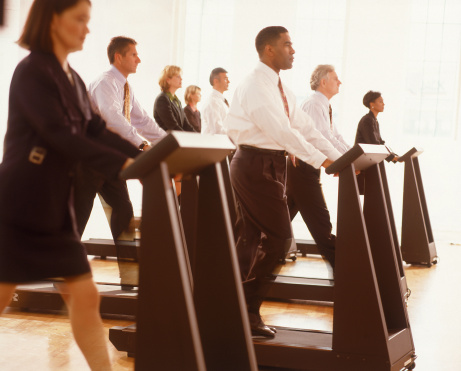
Why are so many people resistant to exercise? We know it’s good for us: It makes us feel great, look youthful & fabulous, and helps us maintain strength and vitality even into our golden years. So why do we resist it so? Check these common excuses most of use to avoid getting physically fit – and how to combat them:
1. “I don’t have the time…”

Is probably the most common excuse to avoid getting fit. This is not to say that there aren’t people out there whose daily schedules aren’t absolutely hectic, but at the end of the day, if there’s a will there’s a way. Say you spend 2 hours a day watching the tube, try spending 1 ½ hours on the TV, and the remainder doing a little cardio, yoga, or whatever mode suits you. In addition try parking a little further away from your favorite café, and get a brief power walk on your way to scoop up your fat free latte. Use the stairs rather than the elevator or escalator.
A more serious commitment to physical fitness could involve a reboot of your weekly schedule were you make significant time toning time. Early am workouts appeal to some, but the key is consistency. The U.S. Surgeon General recommends at least 150 minutes of aerobic activity per week, which is basically slightly over 20 minutes each day.
2. “I’m too tired.”

Here’s the best place to insert Newton’s law “a body in motion stays in motion.” The more sedate your body is, the less energy you’re bound to feel. Exercise has been proven time and again to diminish fatigue and provide energy. Certified athletic trainer Marisa Burnett says, “You’re getting the endorphins [feel-good hormones in your body] to release… and you’re getting the circulation going — as opposed to coming home and crashing on the couch.” In other words, just keep it moving!
3. “My kids keep me from exercising.”

As a mother of two very young and vivacious boys, I continually struggle with this excuse. Whether you’re making trips to the gym or working out at home, making time for fitness takes patience and some creative thinking when little ones are on the scene. The fitness expert consensus is simply to multitask. If you’re able, walk your kids to school, rather than drive. While at the playground, or in your back yard, jump rope, do sit ups or push-ups. Family bike rides are cool since you can burn calories while having fun in the process. You could join a health club with a day care center, or as I do, squeeze in your workouts at home during your little one’s naptime. “And remember,” says psychologist Christina Recascino, PhD, a professor in the human factors department at Embry-Riddle Aeronautical University, “that your fitness is good for your kids as well as you. “When mom or dad is more fit, has more energy, the whole family benefits.”
4. “Working out is way too incomfortable.”

I’m gonna drop another one here: “no pain no gain.” Exercise shouldn’t cause major pain, but when you start to workin’ those muscles you didn’t even know you had, it’s bound to cause some significant discomfort. Consistency is what’s needed to help you get through, and you’ll be amazed to find the discomfort replaced with strength. It’s important not too get gung ho at the start of fitness training. Remember to ease into it, and work your way up to the more intense routines.
5. I can’t seem to stay committed to a fitness routine.

For some of us, the commitment to regular exercise comes and goes, and with it, the results we wish to see when we look in the mirror. Sometimes the idea of a never-ending workout regimen can be a tad daunting, which is why it’s best to just take it a day at a time. The following tips may help you integrate a regular exercise routine into your life without viewing it as an inconvenient obligation:
~Keep things interesting by mixing it up – Try different types of training such as Pilates, cardio, yoga, kickboxing, etc.
~Avoid skipping your scheduled workout because missing just one may lead to the abandonment of regular fitness training altogether.
~Begin with some form of exercise you enjoy doing, and commit to only 15-20 minutes each day.
~Plan your work out schedule in advance, say, a week at a time.
~Make exercise a priority, no matter what fitness level you’re on.
~Focus less on losing weight and more on getting fit and energized. With consistence, and a balanced diet, the pounds will eventually fade away.
6. “I think exercise is boring”

Straight outta WebMD: “Exercise should be like sex,” says sports physiologist Mike Bracko, EdD, FACSM, a certified strength and conditioning specialist and director of the Institute for Hockey Research in Calgary. “You should want it and feel good about it before you do it. And it should feel good while you’re doing it.”
So how do you get there? First, find an activity you love. Think outside the box: try inline skating, dancing, or gardening. Join a sports league. Or, if you love music, try ballroom dancing. “There’s an exercise for everyone,” says Recascino. “It doesn’t have to be onerous or unpleasant.”
If it makes exercise more enjoyable for you, it’s OK to watch Oprah or read while you’re on the exercise bike or treadmill — just don’t forget to pedal or run.
Working out with a group also helps many people. “Not everybody’s cut out to put on their iPod and go on a six-mile run by themselves,” says Peter Nierman, MD, assistant professor of psychiatry at the University of Chicago.”
7. “Gyms are too expensive”

Gym fees can be ridiculously high, and with some gyms’ insistence on long term contracts, many are unwilling to sign away a segment of their annual income to a health club. However, there are facilities such as the YMCA, or other community centers in your area that may provide an affordable alternative. But by no means is a gym a requirement to get that booty in shape. You can walk, run, use free weights – or other multi-sue equipment – use fitness DVD’s, or my personal fave, Exercise TV to maintain your own workout routine. Dig About’s advice page on exercising on a budget for more advice.
8. “I never see the results I work so hard to receive.”

It takes time to put the pounds on, so be patient as you work to burn them off. A healthful diet, and consistent exercise is vital to manifesting visible changes in your appearance. It could take up to 12 weeks before you start noticing your pants starting to sag around your waist. It’s important to set realistic goals for yourself, and stick to them, and remember that the more muscle you produce, the more fat you burn, even when you’re body’s at rest. Dig this piece that explains why some folks have trouble shredding excess pounds.
Frugivore, we’ve all been there. What are some of your “old faithful” excuses to avoid working up a sweat?







Great article!!
I think many of these are actually valid reasons for many people. I absolutely love exercising and I do it regularly but it is VERY difficult to find time for it with family, work and schedule obligations. Sometimes I swap needed sleep for it and I honestly can’t say that’s a very healthy swap. But I do love it so that’s a personal sacrifice I choose to make even if it means feeling like crap the rest of the day because I need sleep lol.
In fact, all kinds of exercise are bad for health if they make you sweat or pant for breath. The scientific evidence for this is very solid. For more info see ‘Why You Should Avoid Exercise’ at http://www.amazon.com/dp/B00RF2XFO4